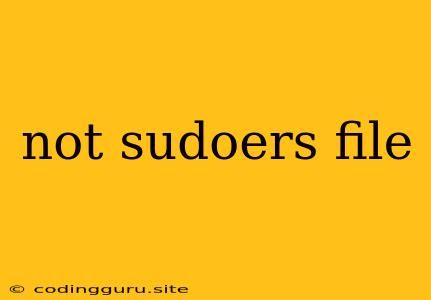The "not in sudoers file" Error: A Comprehensive Guide
The dreaded "not in sudoers file" error is a common problem encountered by Linux users attempting to execute commands with elevated privileges. This error message indicates that your user account is not authorized to use the sudo command. Let's delve into understanding this error and explore various solutions to resolve it.
What is the sudo Command?
The sudo (Super User Do) command in Linux allows users to execute commands with root privileges, similar to the administrator account in Windows. This is crucial for tasks requiring system-wide changes, like installing software, managing system settings, or troubleshooting issues.
Why Do I See the "not in sudoers file" Error?
The root cause of the "not in sudoers file" error lies in the sudoers file. This file, usually located at /etc/sudoers, defines which users are allowed to use the sudo command and under what conditions. If your user account is not listed in the sudoers file, you won't be granted the privilege to execute commands with sudo.
Common Scenarios for the Error
- Newly Created User: If you recently created a user account on a Linux system, it likely won't be automatically added to the
sudoersfile. - Transferred User: When transferring a user account from one system to another, the permissions associated with the
sudocommand may not be transferred properly. - Security Restrictions: System administrators may choose to limit
sudoaccess for specific users for security reasons.
How to Troubleshoot the "not in sudoers file" Error
Here are a few common approaches to resolving the "not in sudoers file" error:
-
Adding User to
sudoersFile:-
Important: Editing the
sudoersfile requires utmost care as any mistakes can render your system unusable. Use a text editor specifically designed for editing configuration files, such asvisudo. -
Steps:
- Open a terminal window and type:
sudo visudo - Locate the line that begins with
rootand add a new line below it with the following format:
ReplaceALL=(ALL) ALL <username>with your actual username. - Save the changes and exit the editor.
- Open a terminal window and type:
-
-
Requesting
sudoAccess:- If you are not authorized to modify the
sudoersfile, contact the system administrator and request them to grant yousudoprivileges.
- If you are not authorized to modify the
-
Confirm User Configuration:
- Double-check that your user account is correctly set up and configured in the system.
-
Verify File Permissions:
- Ensure that the
sudoersfile has the correct permissions:- Permissions:
-rw-r--r--(owner can read/write, others can read)
- Permissions:
- Ensure that the
-
Check for Syntax Errors:
- If you recently modified the
sudoersfile, verify that you did not introduce any syntax errors. Syntax errors in thesudoersfile can prevent it from being loaded properly.
- If you recently modified the
-
System-Wide Issues:
- If the error persists despite trying the above solutions, it may be a system-wide issue requiring more advanced troubleshooting. Consult with a Linux administrator or refer to the system's documentation for further guidance.
Tips for Avoiding the "not in sudoers file" Error
- Best Practices: Always use
sudowith caution and only when absolutely necessary. Avoid using root privileges for day-to-day tasks. - Use Specific Commands: Instead of
sudoalone, usesudo <command>to limit the impact of potential mistakes. - Password Prompts: The
sudocommand often prompts for your password before executing a command. This is a security measure, but it can be annoying. To avoid repeated password entries, use the-Aoption (for all commands in the current session) or the-Hoption (for all commands in the current session). - User Management: Proper user management is key. Create accounts with specific permissions for each user to ensure system security.
Conclusion
Understanding the "not in sudoers file" error and the underlying reasons behind it is crucial for any Linux user. By following the troubleshooting steps and best practices outlined above, you can effectively resolve this issue and gain the necessary permissions to perform administrative tasks on your system.
